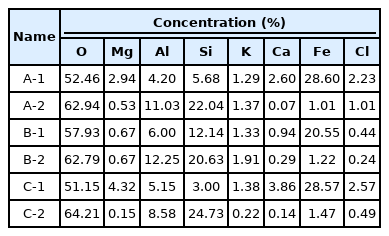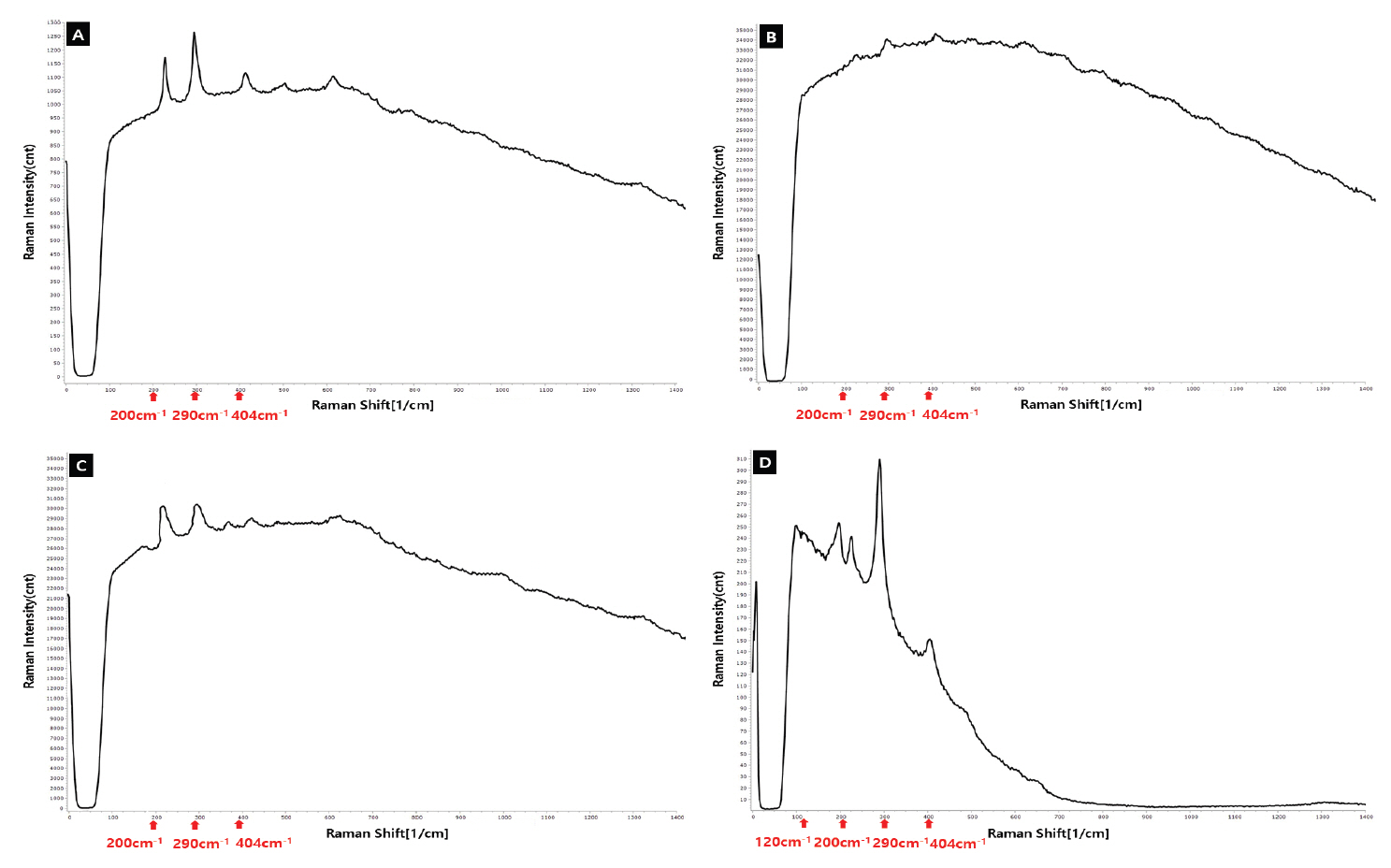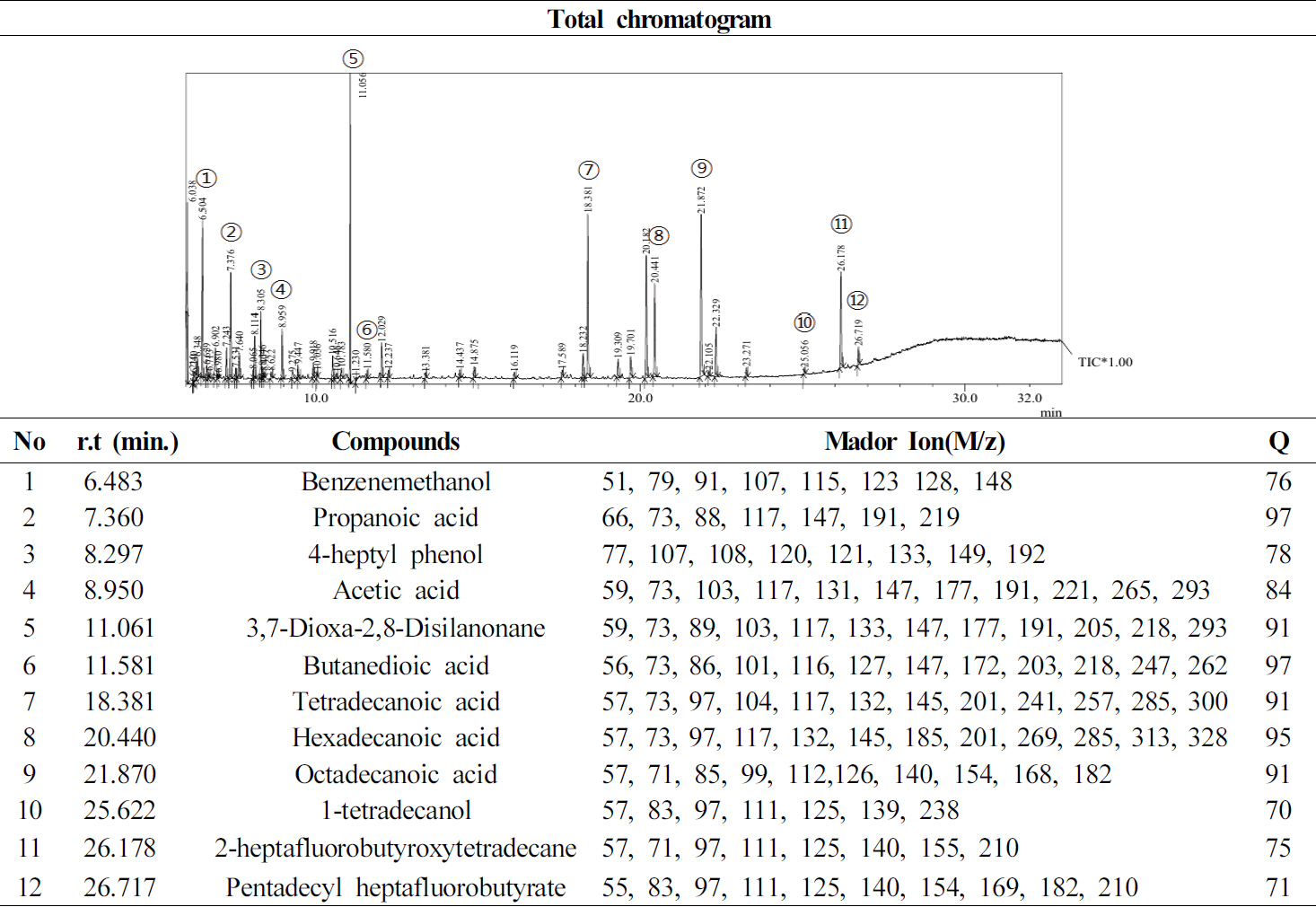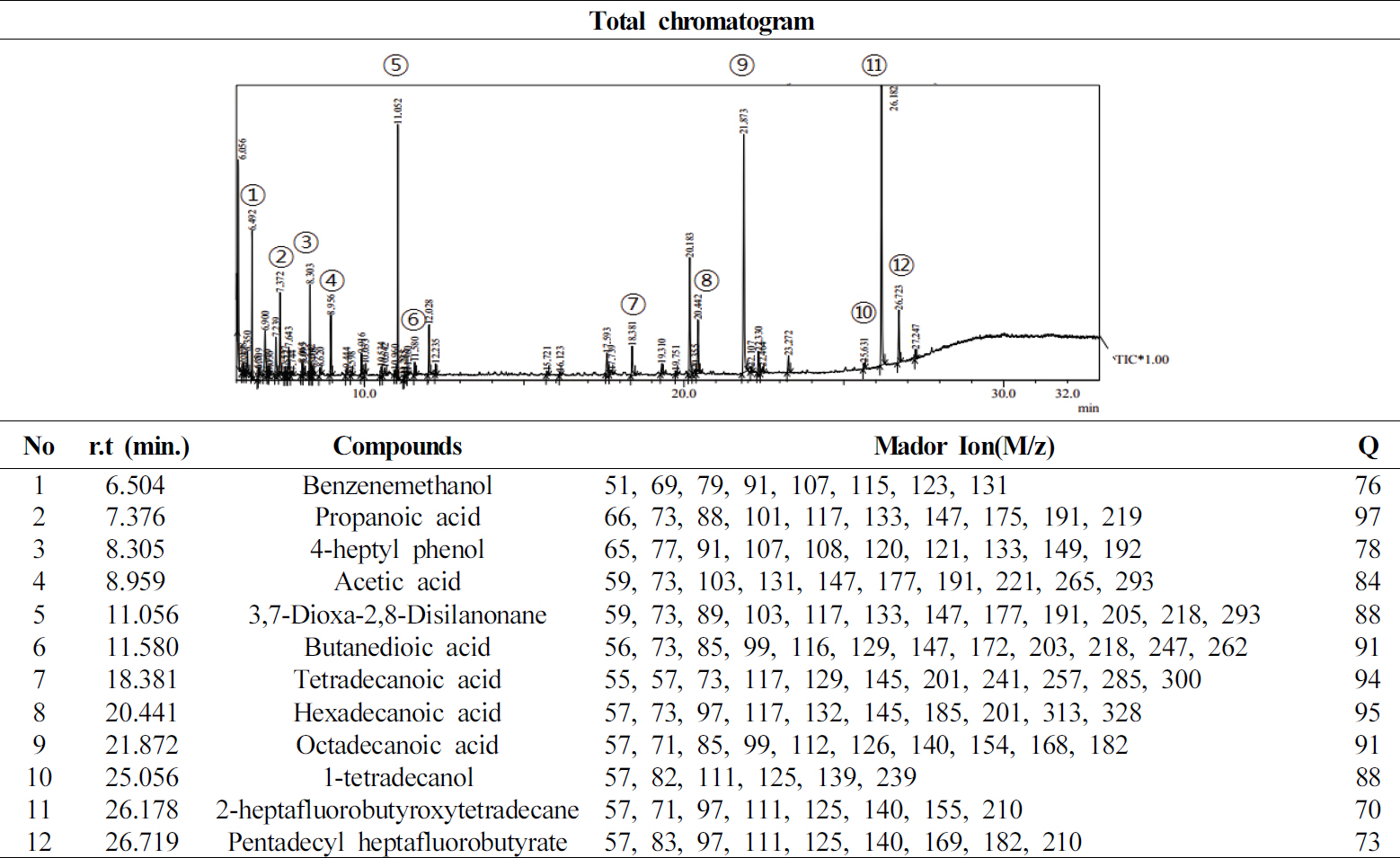한국 고대 붉은 간토기의 적색 안료 및 교착제에 대한 과학적 분석
Study on Scientific Analysis about Red Pigment And Binder - The Korean Ancient Red Pottery -
Article information
Abstract
본 연구에서는 한국 고대 붉은 간토기 중 국립김해박물관 소장품인 적색마연완 붉은 간토기(신석기시대), 단도마연 붉은 간토기(청동기시대), 적색마연가지문 붉은 간토기(청동기시대)에 사용된 적색 안료와 교착제를 확인하여 고대 붉은 간토기에 사용된 적색 안료와 교착제의 종류에 대한 자료를 구축하고자 하였다. 과학적 분석 결과, 붉은 간토기 3점 모두 소지층과 적색의 표면층으로 구분되었으며, 적색의 표면층에서는 적색 안료 입자와 광물의 결정이 보였다. SEM-EDS, Raman 분석을 통해 적색 안료는 산화철(Fe2O3)을 주 발색원으로 하는 토양성 안료 중 석간주로 추정하였으며, FTIR-ATR을 통해 Urushiol polymer의 특징에 의한 성분 피크가 검출되었다. GC/MS 분석 결과, 적색층에서 옻칠의 방향구조에 기인하는 성분인 Benzenemethanol-2-propenyl, 4-heptyl phenol, 1-Tetradecanol, Heptafluorobutyroxytridecane 성분이 검출되었다. 따라서 국립김해박물관 소장품인 붉은 간토기 3점의 적색 안료는 석간주(Fe2O3)를, 교착제로는 옻칠을 사용하여 제작된 토기인 것으로 판단되었다.
Trans Abstract
From the collection of the National Kimhae Museum, qualitative analyses using microscopic observation, SEM-EDS, Raman spectroscopy, FT-IR-ATR spectroscopy, and GC-MS were conducted on three burnished red potteries—Jeoksaekmaoyeonwa burnished red pottery (Neolithic age red pottery), Dandomaoyeonwan burnished red pottery(Bronze age red pottery) and Jeoksaekmaoyeongajimun burnished red pottery(Bronze age red pottery)—to investigate the components of the red pigments and the binder. After the layers of the primer were separated from the red surface, crystals of red pigment particles and minerals were found on the red surface. Through SEM-EDS, Raman estimates that the red pigment is Among soil pigments with iron oxide(Fe2O3) as the main color development source, Red Ocher(Fe2O3). A band characteristic of the Urushiol polymer was detected in the FTIR-ATRspectra(4000∼600cm-1), GC-MS analysis confirmed the presence of the benzenemethanol-2-prophenyl, 4-heptylphenol, 1-tetracecanol, heptafluorobutyric texidecane, all of which are the ingredients of the directional structure of the lacquer present in the red layer. Therefore, it seemed that the three burnished red pottery: Jeoksaekmaoyeonwan pottery(Neolithic age burnished red pottery), Dandomaoyeonwan pottery(bronze age burnished red pottery) and the Jeoksaekmaoyeongajimun pottery(bronze age burnished red pottery) made by mixing minerals and Red Ocher(Fe2O3), with lacquer.
1. 서 론
붉은 간토기는 토기의 표면에 산화철(酸化鐵)을 바르고 반들거리게 문질러서 굽거나 적색 안료를 바른 토기로, 적색마연토기(赤色磨硏土器) 혹은 홍도(紅陶)라고도 부른다(Ahn, 2003). 이는 토기 고유의 저장과 조리 기능 이외에 미학적이고 기능적 측면이 부각된 형태의 토기라고 볼 수 있다(Jang, 2020). 신석기시대의 붉은 간토기는 부산 동삼동⋅김해 수가리⋅거제 산달도⋅통영 상노대도⋅무안 하태도 등 주로 부산과 경상남도 지방에 집중적인 분포를 보이며, 청동기시대의 붉은 간토기는 전라북도 부안 소산리⋅전라남도 나주 노동리⋅대구 대봉동⋅경상북도 월성 용당리⋅부산 괴정2동⋅경상남도 김해 회현리⋅내동⋅무계리⋅창원 외동⋅의창 성문리⋅곡안리⋅ 진주 대평리 등 주로 낙동강 유역에 밀집되어 있다(Ahn, 1982; Jeong, 1980). 이처럼 붉은 간토기는 신석기시대, 청동기시대 전 기간에 걸쳐서 사용되었던 것으로 나타난다.
광물에서 유래된 적색 안료는 화학적으로 안정성이 높아 시기가 지나도 변화가 적기 때문에 자료가 매몰된 당시의 정보를 잘 남기는 고고자료 중 하나이다. 일본의 경우 적색 안료가 유적 또는 무덤에서 대량으로 출토되거나 토기에 도포된 상태로 확인된 경우가 많으며, 일본의 구석기시대와 조몬(繩文)시대부터 적색 안료가 이용된 것으로 알려져다. 그 예로 약 7,000년 전의 이시가와현 미비키(三引)유적에서 출토된 벵갈라 칠도막이 올라간 나무빗이 있다(Maya et al., 2014).
우리나라에서 출토된 붉은 간토기는 겉면에 산화철(Fe2O3)을 주로 도포하여 사용하는 것으로 알려져 있다(Choi, 1998; Sin and Oh, 2010). 이는 산화철(Fe2O3)과 황화수은(HgS)을 토기의 적색 안료로 사용하였던 일본의 경우와 비교된다(Jang, 2020). 또한 일본은 토기에 사용되는 교착제로 갖풀이나 옻이 이용된 경우가 발견되었고(Ha, 2014), 국내는 ‘산림경제’ 제2책 권지4 잡방(第二冊 卷之四 雜方)에 도면 자기와 기와 붙이는 법이 나오며, 1800년 초에 빙허각 이씨가 쓴 ‘규합총서’에는 사기그릇 및 질그릇 등의 접합법과 접합에 사용되는 교착제로 갖풀이나 옻이 사용된다고 언급되어 있다. 또한, 평택 대추리 유적에서 출토된 원삼국 시대로 추정되는 대형옹에 교착제로 옻을 사용한 연구(Cho et al., 2010)가 진행된 적이 있다. 하지만 과거 토기에 사용된 교착제가 사용된 흔적은 그 사례를 찾기 힘들며, 이러한 특성을 검토할 필요가 있다.
따라서 본 연구에서는 국립김해박물관 소장품인 붉은 간토기 3점(적색마연완 붉은 간토기(신석기시대), 단도마연 붉은 간토기(청동기시대), 적색마연가지문 붉은 간토기(청동기시대))을 대상으로 과학적 분석을 시행하여 신석기, 청동기시대 토기에 사용된 적색 안료의 성분과 교착제의 종류를 확인하여 고대에 사용된 적색 안료와 교착제의 종류에 대한 효과적인 자료를 제공하고자 하였다.
2. 재료 및 방법
2.1. 분석 대상
분석 대상은 적색마연완, 단도마연, 적색마연가지문 붉은 간토기 3점(Figure 1)이다. 이 중 적색마연완 붉은 간토기(A) 1점은 신석기시대, 단도마연(B), 적색마연가지문(C) 붉은 간토기 2점은 청동기시대에 제작된 것으로 추정된다(Table 1).

Analysis target. (A) Jeoksaekmaoyeonwan burnished red pottery, (B) Dandomaoyeonwan burnished red pottery, (C) Jeoksaekmaoyeongajimun burnished red pottery.
2.2. 시료 채취 및 전처리 방법
분석을 위한 시료는 분석 대상 표면에서 탈락된 편을 수습하여 진행하였다. 수습한 편을 실체현미경(SMZ800N, Nikon, JPN) 10배율 관찰 후 지름 15 mm 실리콘 고정 틀에 임시 고정하고, 에폭시 수지(Epofix, Struers, DNK)로 실온에서 24시간 동안 완전 경화시켰다. 경화된 에폭시 수지는 시료 절단기(Minitom, Struers, DNK)를 이용해 10∼20 µm 크기로 절단 후 시편에 부착된 이물질 등을 제거하기 위해 증류수가 담긴 초음파세척기를 이용해 세척하였다.
2.3. 현미경 관찰
전처리 과정을 통해 제작된 시편을 76 × 26 mm 크기의 슬라이드글라스에 부착하여 고정한 다음 Sand Paper #5,000으로 연마하였으며, 연마 후 증류수가 담긴 초음파 세척기를 이용해 이물질을 제거하였다. 세척 후 Glycerin (50%)을 떨어뜨린 뒤 커버글라스를 덮어 프레파라트를 완성했다. 제작된 프레파라트는 편광현미경(DM2700P, Leica, GER)으로 투과광, 편광, 낙사광에서 100배율로 표면층을 관찰하였다.
2.4. SEM-EDS 분석
적색마연완, 단도마연, 적색마연가지문 붉은 간토기 3점에 적색 안료 성분을 확인하기 위해 주사전자현미경-에너지분산형 분석기을 사용하여 분석하였다. 분석 시편은 전처리 과정을 통해 제작한 시편으로 진행하였으며, 적색 안료가 도포된 부분으로 추정되는 표면층과 바탕층으로 추정되는 소지층을 분석하였다. 제작된 시편은 금으로 코팅한 후 시료대에 고정시켜 전압 20 kV, 작업거리 20 mm 조건으로 분석하였다. 주사전자현미경(Scanning Electron Microscpoe(SEM), JSM-5500LV, JEOL, JPN)을 사용하여 고배율로 관찰한 후, 주사전자현미경에 부착된 에너지분산형 분석기(Energy Dispersive Spectroscopy(EDS), X-Stream, INCA, JPN)를 이용하여 성분 분석을 실시하였다.
2.5. Raman
적색마연완, 단도마연, 적색마연가지문 붉은 간토기 3점에 사용된 적색 안료와 추정 안료(대조군)인 석간주(Fe2O3)를 라만분광분석기(LabRam ARAMIS, Jobin Yvon, Horiba, JPN)를 사용하여 분석하였다. 수습한 탈락된 편 중 적색 안료 부분을 일부 채취해 광원은 Nd:YAG(532nm), 강도는 30 mW로 고정하고 필터(Filter)는 D1, D2를 사용하여 강도를 조절하였다. 격자(Grating)는 600 g/mm, 홀(Hole)과 슬릿(Slit)은 200 µm로 측정하였으며, 측정 조건 변경 시 Silicon Standard를 이용하여 라만 shift를 보정하였다.
2.6. FTIR-ATR
전처리 과정을 통해 제작된 시편에서 교착제로 추정되는 부분을 FTIR 장비(Cary620 Microscope, Agilent, USA), ATR 모드로 분석하여 사용된 교착제를 확인하였다. FTIR 장비에 부착된 현미경을 통해 교착제로 추정되는 부분을 확인한 후, 분해능 4 cm-1, 분석 범위(range) 600∼4000 cm-1, 스캔 횟수(scans) 32회로 설정하여 시료별로 3회 반복 측정하였다.
2.7. GC/MS
GC/MS 분석용 시편(0.2∼0.3 mg)은 methyl alcohol 200 ul를 첨가한 후 원심분리하여 상층액만 취해 동결 건조시켰다. 동결 건조된 Sample에 피리딘(pyridine, 순도 99.9%) 용액을 20 ul를 넣어 시료는 모두 분산시켰다. 극성을 나타낼 수 있는 amine이나 -OH, -COOH의 극성 부분을 BSTFA(N,O-bis(trimethylsilyl) trifluoroacetamide)를 이용하여 -OSi(CH3)3화시킴으로써 GC/MS의 분석에 용이하도록 유도체화하였다. GC는 DB-5(0.25 mm × 60 m, film thickness 0.25 μm) column이 장착된 GCMS-QP2010 plus(Shimadzu, JPN)을 사용하였으며, 주입기온도 280˚, 오븐 온도 70˚C에서 3분간 유지시킨 후 10˚C/min의 속도로 승온하여 300˚C에서 5분간 유지시켰다. Carrier gas는 헬륨(He)을 1 mL/min 흐름 속도로 사용하였고, 시료 1 μL 주입하여 split ratio 30:1에서 분석하였다. GC/MS는 Interface 온도 250˚C, EI ionization voltage는 70 eV 사용하였다. 분자량의 분석 범위는 50-550 m/z 영역을 SCAN mode로 분석하였으며, 각 물질의 깨짐 현상(Fragmentation)을 통하여 모든 물질을 정성하였다.
3. 결 과
3.1. 현미경 관찰
Figure 2는 적색마연완, 단도마연, 적색마연가지문 붉은 간토기 3점에 대한 현미경 관찰 결과이다. 모두 투과광에서 소지층 위로 적색의 표면층이 관찰되었다. 적색층의 두께는 적색마연완 약 165 µm, 단도마연 약 150 µm, 적색마연가지문 약 80 µm로 측정되었다. 편광에서는 소지층의 결정이 관찰되었고, 표면층에서는 적색 입자와 광물의 결정이 보였다. 낙사광에서는 표면층이 적색으로 보였다.
3.2. SEM-EDS 및 Raman 분석
적색마연완, 단도마연, 적색마연가지문 붉은 간토기 표면층 및 소지층에 대한 SEM-EDS 분석 결과, 표면층에서는 철(Fe) 성분이 높게 검출되었으며, 그 밖에 지각을 구성하는 규소(SI), 알루미늄(Ai), 칼슘(Ca), 칼륨(K) 성분들이 검출되었다. 또한, 소지층에서는 규소(SI), 알루미늄 (Al), 칼슘(Ca), 칼륨(K) 성분들이 높게 검출되었다(Table 2, Table 3, Figure 3). 또한 적색 안료 성분에 대한 명확한 확인을 위해 Raman 분석을 하였다.

Result of typical spectrum. (A) Jeoksaekmaoyeonwan burnished red pottery, (B) Dandomaoyeonwan burnished red pottery, (C) Jeoksaekmaoyeongajimun burnished red pottery.
또한, 적색 안료 성분에 대한 명확한 확인을 위해 Raman 분석을 실시하였다. 적색마연완, 단도마연, 적색마연가지문 붉은 간토기 적색 안료에 대한 Raman 분석 결과, Raman Shift(cm-1) 198 cm-1, 225 cm-1, 290 cm-1, 404 cm-1에서 강한 피크가 검출되었다. 대조군(석간주(Fe2O3)) 데이터베이스와 비교한 결과, Raman Shift(cm-1) 198 cm-1, 290 cm-1, 404 cm-1에서 유사한 결괏값을 보였다. 따라서 적색마연완, 단도마연, 적색마연가지문 붉은 간토기에 산화철(Fe2O3)을 주 발색원으로 하는 토양성 안료 중 석간주를 이용하여 표면층(적색층)을 구성한 것으로 추정된다(Table 4, Figure 4).
3.3. FTIR-ATR
FTIR-ATR 분석은 적색마연완, 단도마연, 적색마연가지문 붉은 간토기의 적색층을 대상으로 분석하였다(Figure 5). 그 결과, Figure 6에서 확인되는 바와 같이 적색마연완, 단도마연, 적색마연가지문 붉은 간토기의 적색층에서 수산기(O-H)에 의한 3560∼3200 cm-1, 메틸렌기(-CH₃, =CH₂)의 비대칭 대칭 신축 진동에 기인하는 2920∼2850 cm-1에서 peak가 확인되었고, 1,500 cm-1 이하 지문영역에서 1455 cm-1에서 메틸렌기의 굽힘(Bending) 진동에 기인하는 peak가 미세하게 관찰되었으며, 720 cm-1, 696 cm-1에서 미세한 peak가 관찰되었다. 이는 옻칠의 주성분인 Urushiol polymer의 특징으로 옻칠은 3560∼3200 cm-1(수산기(O-H)에 의한 흡광피크), 2920∼2850 cm-1(메틸렌기 (-CH3, =CH2)의 비대칭 대칭 신축 진동), 1730∼1600 cm-1(C=C, C=O 이중결합에 의한 신축진동), 1455 cm-1 (메틸렌기 굽힘 진동), 991 cm-1(공역트리엔), 860 cm-1 (1,2,3,5-치환 벤젠구조를 가지는 디페닝혈 고분자게), 720 cm1 (Urushiol polymer의 특징인 1,2,3-Trisubstituted benzene)에서 peak가 관찰된다(Cho et al., 2010; Choi and Kim, 2018; Kim, 2007). 또한 1200∼950 cm-1에서 넓은 peak가 관찰되었으며, 780 cm-1에서의 미세한 peak가 관찰되었다. 이는 석영, 장석, 적철석, 점토광물 등에 의한 성분으로 판단된다(Lee et al., 2015).

Measurement point for FTIR-ATR. (A) Jeoksaekmaoyeonwan burnished red pottery, (B) Dandomaoyeonwan burnished red pottery, (C) Jeoksaekmaoyeongajimun burnished red pottery, (D) Red Ocher+Lacquer.
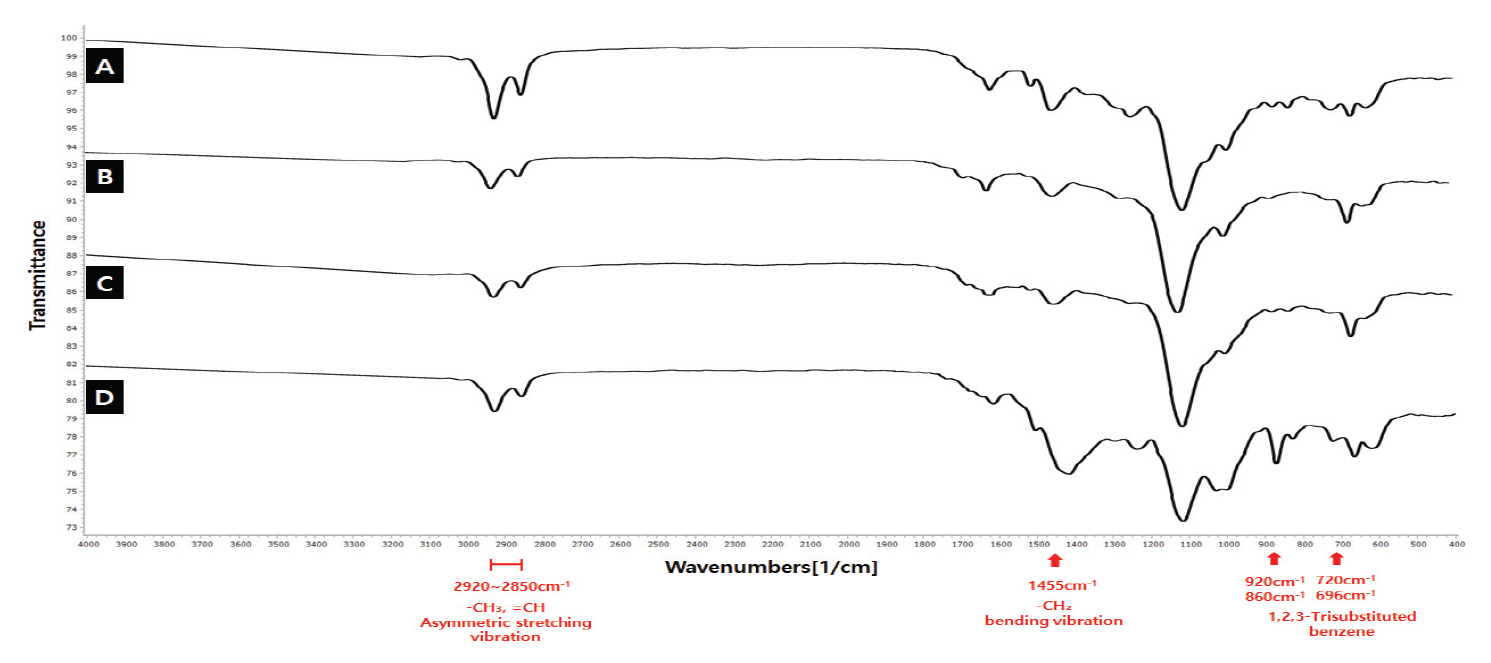
FTIR-ATR spectra of samples (4000∼600 cm-1). (A) Jeoksaekmaoyeonwan burnished red pottery, (B) Dandomaoyeonwan burnished red pottery, (C) Jeoksaekmaoyeongajimun burnished red pottery, (D) Red Ocher+Lacquer.
석간주(Fe2O3)와 옻칠(교착제)을 섞어 제작한 대조군을 대상으로 추가 분석을 실시한 결과, 적색마연완, 단도마연, 적색마연가지문 붉은 간토기 적색층과 석간주(Fe2O3)와 옻칠(교착제)을 섞어 제작한 대조군의 적색층이 유사한 스펙트럼 양상을 보인 것으로 확인되었다(Figure 6).
3.4. GC/MS
GC/MS 분석 결과, 공통으로 모든 시료에서 옻칠의 주성분인 Urushiol polymer의 특징 성분이 유사하게 검출되었다(Figure 8∼10). 검출된 성분은 적색마연완, 단도마연, 적색마연가지문 붉은 간토기에서 Benzenemethanol-2-propenyl, 4-heptyl phenol 성분과 1-Tetradecanol, Pentadecane, Heptafluorobutyroxytridecane의 지방족탄화수소구조로부터 기인하는 성분이 검출되었다.
또한 Pentadecyl heptafluorobutyrate도 검출되었는데, 이는 side chain-side chain 간의 결합으로 길어진 탄화수소가 분해되면서 나타나는 것으로 판단된다. 특히 Benzenemethanol2-propenyl(m/z 123), 4-heptyl phenol(m/z 108) 성분은 옻칠의 방향구조로부터 기인하는 Benzene계 화합물 및 Phenol계 화합물 성분이며, 선행 연구에 따르면 Urushiol polymer 구조를 이루는 카테콜 유도체가 분해하면서 나타나는 주요 Major ion은 m/z 108과 123으로 m/z 123의 경우 2-methoxy-4-methylphenol, 3-methyl-1,2-benzenediol부터 3-pentadecyl-1,2-benzenediol까지 1,2-benzenediol과 그 유도체들이, m/z 108의 경우 2-methylphenol, pen-tadecylphenol 등 다양한 phenol류 화합물들이 관찰된다. 또한, 1-Tetradecanol, Heptafluorobutyroxytridecane은 지방족탄화 수소구조로 이 중 1-Tetradecanol은 Rhus vernicifera의 특징인 것으로 알려져 있다(Cho et al., 2010; Chung et al., 2017; Choi and Kim, 2018; Park and Ahn, 2018).
4. 고찰 및 결론
본 연구는 한국 고대 붉은 간토기에 사용된 적색 안료와 교착제 성분을 확인하기 위해 국립김해박물관 소장품 중 적색마연완, 단도마연, 적색마연가지문 붉은 간토기 3점을 대상으로 과학적 분석(현미경 관찰, SEM-EDS, Raman, FTIR-ATR, GC/MS)을 실시하였다. 현미경 관찰 결과, 소지층 위로 적색층이 관찰되었으며, 적색 안료와 광물의 결정이 보였다. SEM-EDS, Raman을 이용하여 적색 안료는 석간주(Fe2O3)를 사용하였던 것으로 추정할 수 있었고, FTIR-ATR과 GC/MS 분석 결과, 옻칠의 주성분인 Urushiol polymer 성분이 검출된 것을 보아 옻을 교착제로 사용한 것으로 판단되었다.
이 중 교착제로 사용된 옻은 고문헌인 산림경제(山林經濟), 규합총서(閨闔叢書), 오주서종박물고변(五州書種博物考辨) 등의 기록에 의하면 일반적으로 목재, 도자기, 모시 등에 칠하는 용도로 사용하였으며, 때로는 깨진 토기, 자기와 기와 등의 접착제로도 이용한 사례가 언급되었다(Yang, 2014).
현재 우리나라 옻칠의 기원은 불확실하나 기원전 3세기 아산 남성리 유적에서 칠 편이 출토된바 있고, 현존하는 최고(最古)의 칠기 문화재로는 기원전 108년에 제작된 낙랑시대의 목심칠기 및 협저칠기가 있다(Choi et al., 2011; Kim, 2007). 동북아시아의 옻칠 문화의 시기를 고려하면, 우리나라 신석기시대 유물 중에서도 옻칠된 유물이 출토될 것으로 기대되고 있으나 현재까지 신석기시대 유적에서 옻나무나 옻칠된 유물이 출토된 사례는 없었다(Gimhae National Museum Special Exhibition, 2019). 이번 연구 결과를 통해 우리나라 신석기시대 유물 중 옻칠이 교착제로 사용된 사례를 확인할 수 있었으며, 우리나라 옻칠의 학술적 주요 정보를 마련하고 효과적인 자료를 제공하고 우리나라 신석기시대 유물 중에서도 옻칠이 사용된 사례를 제시할 바탕이 될 것으로 기대된다.
Acknowledgements
본 연구는 국립김해박물관 특별전 ‘고대의 빛깔, 옻칠’(2019. 6. 25.∼9. 29.)의 목적으로 수행되었으며, 국립김해박물관의 시료 협조에 감사드립니다.



